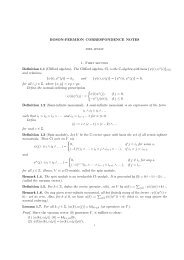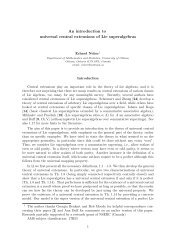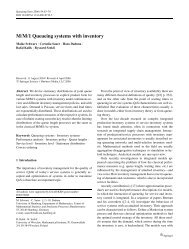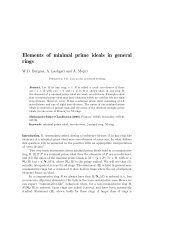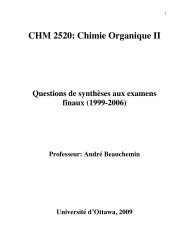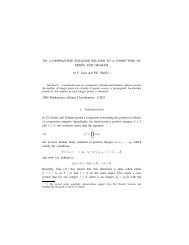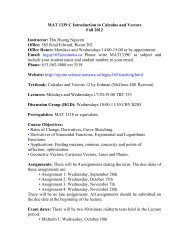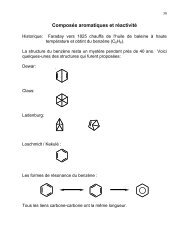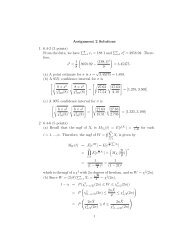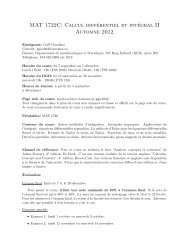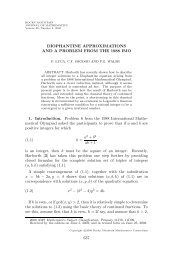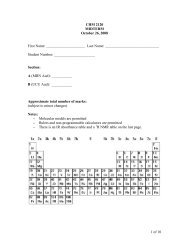invertible and nilpotent elements in the group algebra
invertible and nilpotent elements in the group algebra
invertible and nilpotent elements in the group algebra
You also want an ePaper? Increase the reach of your titles
YUMPU automatically turns print PDFs into web optimized ePapers that Google loves.
INVERTIBLE AND NILPOTENT ELEMENTS IN THE GROUP<br />
ALGEBRA OF A UNIQUE PRODUCT GROUP<br />
ERHARD NEHER<br />
Abstract. We describe <strong>the</strong> <strong>nilpotent</strong> <strong>and</strong> <strong><strong>in</strong>vertible</strong> <strong>elements</strong> <strong>in</strong> <strong>group</strong> <strong>algebra</strong>s<br />
k[G] for k a commutative associative unital r<strong>in</strong>g <strong>and</strong> G a unique product<br />
<strong>group</strong>, for example an ordered <strong>group</strong>.<br />
Introduction. A fundamental problem <strong>in</strong> <strong>the</strong> <strong>the</strong>ory of <strong>group</strong> <strong>algebra</strong>s is to<br />
determ<strong>in</strong>e <strong>the</strong>ir units = <strong><strong>in</strong>vertible</strong> <strong>elements</strong>. The reader can f<strong>in</strong>d a short <strong>in</strong>troduction<br />
to this question <strong>in</strong> [3, §6] <strong>and</strong> a much more substantial one <strong>in</strong> [6, Ch. 13] <strong>and</strong><br />
[7, Ch. II <strong>and</strong> VI]. S<strong>in</strong>ce 1 − a is <strong><strong>in</strong>vertible</strong> for any <strong>nilpotent</strong> element a, a closely<br />
related problem is that of describ<strong>in</strong>g all <strong>nilpotent</strong> <strong>elements</strong>.<br />
In this short note we give a description of <strong>the</strong> <strong>nilpotent</strong> <strong>and</strong> <strong><strong>in</strong>vertible</strong> <strong>elements</strong><br />
<strong>in</strong> <strong>group</strong> <strong>algebra</strong>s k[G] where k is an arbitrary commutative associative unital r<strong>in</strong>g<br />
<strong>and</strong> G is a unique product <strong>group</strong>, e.g. an ordered <strong>group</strong> (Cor. 5.). Our result is<br />
well-known <strong>in</strong> case k is an <strong>in</strong>tegral doma<strong>in</strong>: If G is a unique product <strong>group</strong>, 0 is<br />
<strong>the</strong> only <strong>nilpotent</strong> element <strong>and</strong> all units are trivial. So <strong>the</strong> ma<strong>in</strong> po<strong>in</strong>t here is <strong>the</strong><br />
generality of k.<br />
Our approach uses a little bit of <strong>algebra</strong>ic geometry <strong>and</strong> might possibly also be<br />
of <strong>in</strong>terest to solve o<strong>the</strong>r problems related to <strong>group</strong> <strong>algebra</strong>s. It is <strong>in</strong>spired by a<br />
recent result of Ottmar Loos <strong>in</strong> [4], where he determ<strong>in</strong>es <strong>the</strong> <strong><strong>in</strong>vertible</strong> <strong>elements</strong> <strong>in</strong><br />
a Laurent polynomial r<strong>in</strong>g k[t ±1 ]. In Th. 3 we describe <strong>the</strong> <strong>nilpotent</strong> <strong>and</strong> <strong><strong>in</strong>vertible</strong><br />
<strong>elements</strong> <strong>in</strong> k[G] under <strong>the</strong> assumption that for all k-<strong>algebra</strong>s K which are fields<br />
<strong>the</strong> <strong>group</strong> <strong>algebra</strong> K[G] is a doma<strong>in</strong> or, respectively, has only <strong>the</strong> trivial units. The<br />
case of <strong>group</strong> <strong>algebra</strong>s k[G] for G a unique product <strong>group</strong> is <strong>the</strong>n an immediate<br />
corollary.<br />
A different characterization of <strong>the</strong> units <strong>in</strong> k[G] for G a right-ordered <strong>and</strong> thus<br />
unique product <strong>group</strong> is proven <strong>in</strong> [5].<br />
1. Notation. Throughout we use <strong>the</strong> follow<strong>in</strong>g notation: k is a commutative<br />
associative unital r<strong>in</strong>g, Spec(k) is <strong>the</strong> prime spectrum of k equipped with <strong>the</strong> Zariski<br />
topology, κ(p) is <strong>the</strong> quotient field of k/p for p ∈ Spec(k), x(p) is <strong>the</strong> canonical image<br />
of x ∈ k <strong>in</strong> κ(p) <strong>and</strong> k-alg is <strong>the</strong> category of associative commutative <strong>and</strong> unital<br />
k-<strong>algebra</strong>s. The <strong><strong>in</strong>vertible</strong> <strong>elements</strong> of an associative unital k-<strong>algebra</strong> A are denoted<br />
A × .<br />
Let G be a <strong>group</strong>, written multiplicatively <strong>and</strong> let A = k[G] be <strong>the</strong> <strong>group</strong> <strong>algebra</strong><br />
of G over k. Thus A is a free k-module with k-basis (u g : g ∈ G) <strong>in</strong> bijection with<br />
2000 Ma<strong>the</strong>matics Subject Classification. Primary 16S34; Secondary 06F15, 16U60, 20F60.<br />
Key words <strong>and</strong> phrases. Units, <strong>nilpotent</strong> <strong>elements</strong>, <strong><strong>in</strong>vertible</strong> <strong>elements</strong>.<br />
The author was partially supported by a Natural Sciences <strong>and</strong> Eng<strong>in</strong>eer<strong>in</strong>g Research Council<br />
of Canada Discovery Grant.<br />
1
2 ERHARD NEHER<br />
G by g ↦→ u g <strong>and</strong> <strong>the</strong> multiplication of <strong>the</strong> k-<strong>algebra</strong> A is determ<strong>in</strong>ed by <strong>the</strong> rule<br />
u g u h = u gh for g, h ∈ G. It is immediate that any element xu g , x ∈ k × is <strong><strong>in</strong>vertible</strong>.<br />
These are <strong>the</strong> so-called trivial units of A.<br />
We endow G with <strong>the</strong> discrete topology. Recall <strong>the</strong> def<strong>in</strong>ition of <strong>the</strong> constant<br />
<strong>group</strong> scheme G associated to G [2, II, §1, no. 2.12]: For R ∈ k-alg, G(R) is <strong>the</strong> set<br />
of cont<strong>in</strong>uous (= locally constant) maps d : Spec(R) → G with <strong>the</strong> <strong>group</strong> structure<br />
<strong>in</strong>herited from G. In particular, this applies to R = k.<br />
S<strong>in</strong>ce Spec(k) is quasi-compact [1, II, §4.3, Prop. 12], it follows from [1, II, §4.3,<br />
Prop. 15] that <strong>the</strong>re exists a bijection I : G(k) → E from G(k) to <strong>the</strong> set E of all<br />
families ε = (ε g ) g∈G of orthogonal idempotents <strong>in</strong> k with ε g ≠ 0 for only f<strong>in</strong>itely<br />
many g ∈ G <strong>and</strong> ∑ g∈G ε g = 1 k . The bijection d ↦→ I(d) = (ε g ) g∈G is given by <strong>the</strong><br />
relations<br />
d(p) = g ⇐⇒ ε g ∉ p ⇐⇒ p ∈ (Spec(k)) εg ⇐⇒ ε g (p) = 1 κ(p) (1)<br />
where, for x ∈ k, (Spec(k)) x denotes <strong>the</strong> basic open subset of all p ∈ Spec(k) with<br />
x ∉ p. We will usually view I as an identification. The product of ε = (ε g ) <strong>and</strong><br />
ε ′ = (ε ′ g) <strong>in</strong> <strong>the</strong> <strong>group</strong> G(k) is <strong>the</strong>n given by <strong>the</strong> formula<br />
(ε · ε ′ ) x = ∑ gh=x ε gε ′ h<br />
, (x ∈ G) (2)<br />
Indeed, a locally constant function d : Spec(k) → k gives rise to a partition of<br />
Spec(k) by basic open sets Spec(kε g ) = Spec(k) εg , where ε = (ε g ) is <strong>the</strong> complete<br />
orthogonal system correspond<strong>in</strong>g to d <strong>and</strong> where Spec(k) x is canonically identified<br />
with a subset of Spec(k). Given two locally constant functions d <strong>and</strong> d ′ with<br />
correspond<strong>in</strong>g orthogonal systems ε = I(d) <strong>and</strong> ε ′ = I(d ′ ) we get a partition of<br />
Spec(k) by open sets<br />
(<br />
Spec(k)<br />
)<br />
ε g<br />
∩ ( Spec(k) ) ε ′ h<br />
= ( Spec(k) ) ε g ε ′ h<br />
= Spec(kε g ε ′ h)<br />
on which <strong>the</strong> function dd ′ has <strong>the</strong> value gh. Hence dd ′ has value x ∈ G precisely on<br />
⋃<br />
gh=x Spec(kε gε ′ h ) = Spec ( k( ∑ gh=x ε gε ′ h )) .<br />
In terms of <strong>the</strong> ε’s, <strong>the</strong> unit element of G(k) is <strong>the</strong> family ε (0) = (ε (0)<br />
g<br />
ε (0)<br />
g =<br />
{<br />
1 k , g = 1 G ,<br />
0, g ≠ 1 G .<br />
<strong>and</strong> <strong>the</strong> <strong>in</strong>verse of ε = (ε g ) g∈G is ε −1 = (ε −1<br />
g ) g∈G with ε −1<br />
g = ε g −1.<br />
) with<br />
Let now A = k[G] be <strong>the</strong> <strong>group</strong> <strong>algebra</strong> of G. We <strong>the</strong>n have a <strong>group</strong> monomorphism<br />
G(k) → k[G] × ,<br />
d ↦→ u d := ∑ g∈G ε gu g , for ε = I(d).<br />
Indeed, it follows from (2) that u d u d ′ = u dd ′ for all d, d ′ ∈ G(k).<br />
We recall that a nil ideal of an associative <strong>algebra</strong> A is an ideal consist<strong>in</strong>g of<br />
<strong>nilpotent</strong> <strong>elements</strong>. By def<strong>in</strong>ition [3, 10.26], <strong>the</strong> upper nil radical of an associative<br />
<strong>algebra</strong> A is <strong>the</strong> sum Nil ∗ (A) of all nil ideals of A, equivalently, Nil ∗ (A) is <strong>the</strong> biggest<br />
nil ideal of A. If A is also commutative, Nil ∗ (A) = {a ∈ A : a <strong>nilpotent</strong>} = Nil(A),<br />
<strong>the</strong> nil radical of A.
INVERTIBLE AND NILPOTENT ELEMENTS IN THE GROUP ALGEBRA OF A UNIQUE PRODUCT GROUP3<br />
2. Theorem. (a) Assume K[G] is a doma<strong>in</strong> for every field K ∈ k-alg. Then<br />
<strong>the</strong> upper nil radical of k[G] is<br />
Nil ∗ (k[G]) = { ∑ g∈G n gu g : n g ∈ Nil(k) for every g ∈ G } ∼ =<br />
(<br />
Nil(k)<br />
)<br />
[G]. (3)<br />
It co<strong>in</strong>cides with <strong>the</strong> set of <strong>nilpotent</strong> <strong>elements</strong> of k[G].<br />
(b) Suppose that K[G] has only trivial units whenever K ∈ k-alg is a field. Then<br />
an element a ∈ k[G] is <strong><strong>in</strong>vertible</strong> if <strong>and</strong> only if <strong>the</strong>re exists d ∈ G(k), a unit v ∈ k ×<br />
<strong>and</strong> an element n ∈ Nil ∗ (k[G]) such that<br />
a = v u d + n; (v ∈ k × , d ∈ G(k), n ∈ Nil ∗ (k[G])). (4)<br />
The element d is uniquely determ<strong>in</strong>ed by a, called <strong>the</strong> degree of a <strong>and</strong> <strong>the</strong> map<br />
is a <strong>group</strong> homomorphism.<br />
deg : k[G] × → G(k),<br />
deg(v u d + n) = d<br />
Proof. (a) We abbreviate A = k[G]. It is easily seen that N := { ∑ g∈G n gu g :<br />
n g ∈ Nil(k) for every g ∈ G } is an ideal of A consist<strong>in</strong>g of <strong>nilpotent</strong> <strong>elements</strong>.<br />
Indeed, as an element of A, an n ∈ N has only f<strong>in</strong>itely many non-zero components,<br />
say n 1 u g1 , . . . , n p u gp . Hence <strong>the</strong>re exists q ∈ N such that n q i = 0 for all 1 ≤ i ≤ p.<br />
Then n pq is a sum of terms n r1<br />
1 · · · nrp p u g where g is an appropriate product of pq<br />
factors taken from <strong>the</strong> g 1 , . . . , g r <strong>and</strong> where at least one r i ≥ q. Thus n pq = 0.<br />
Hence N ⊂ Nil ∗ (A) (observe that this holds <strong>in</strong> general).<br />
To f<strong>in</strong>ish <strong>the</strong> proof of (a), it is now sufficient to show n ∈ N for every <strong>nilpotent</strong><br />
element n of A. We write n = ∑ g∈G n gu g with n g ∈ k <strong>and</strong> let p ∈ Spec(k).<br />
The element n(p) ∈ A ⊗ k κ(p) ∼ = ( κ(p) ) [G] is <strong>the</strong>n <strong>nilpotent</strong> too. But s<strong>in</strong>ce by<br />
assumption κ(p)[G] is a doma<strong>in</strong>, it follows that n(p) = 0, i.e., n g (p) = 0 for all<br />
p ∈ Spec(k) <strong>and</strong> all g ∈ G. Thus, every n g is <strong>nilpotent</strong> <strong>and</strong> n ∈ N.<br />
(b) We will first show that any element of <strong>the</strong> form (4) is <strong><strong>in</strong>vertible</strong>. This is<br />
clear for vu ε , so that it suffices to prove <strong>in</strong>vertibility of (vu ε ) −1 a = 1 + v −1 u δ n for<br />
δ = ε −1 . But this is clear s<strong>in</strong>ce v −1 u δ n ∈ N is <strong>nilpotent</strong>.<br />
Conversely, suppose that a ∈ k[G] is <strong><strong>in</strong>vertible</strong>. If k is a field, a has <strong>the</strong> form<br />
a = vu g for some v ∈ k × by assumption, which is a special case of (4).<br />
Let now k be arbitrary. We write a = ∑ g∈G a gu g with a g ∈ k. Let p ∈ Spec(k).<br />
Then <strong>the</strong>re exits a unique g ∈ G such that a(p) = a g (p)u g ≠ 0. This gives rise to<br />
a map d : Spec(k) → G which, we claim, is locally constant. Indeed, if d(p 0 ) = g<br />
<strong>the</strong>n a g (p) ≠ 0 <strong>and</strong> hence a g (p) ≠ 0 for all p <strong>in</strong> <strong>the</strong> basic open neighborhood<br />
U = (Spec(k)) x , x = a g . S<strong>in</strong>ce <strong>the</strong>n a h (p) = 0 for all h ≠ g <strong>and</strong> p ∈ U, we see that<br />
d is constant equal to g on U. Thus d ∈ G(k).<br />
Let ε = (ε g ) g∈G be <strong>the</strong> family correspond<strong>in</strong>g to d. Then ( a g (1 − ε g ) ) (p) = 0 for<br />
all p ∈ Spec(k). Indeed, if d(p) = g <strong>the</strong>n (1−ε g )(p) = 1 κ(p) −1 κ(p) = 0 by (1), while<br />
if d(p) ≠ g <strong>the</strong>n a g (p) = 0 by def<strong>in</strong>ition of d. Hence n g = a g (1−ε g ) ∈ k is <strong>nilpotent</strong>.<br />
Also v = ∑ g∈G a gε g ∈ k × s<strong>in</strong>ce, for any p ∈ Spec(k), v(p) = ∑ g∈G a g(p)ε g (p) =<br />
a d(p) (p) ≠ 0. Thus,<br />
a = ∑ g∈G a gε g u g + ∑ g∈G a g(1 − ε g )u g = ( ∑ g∈G a ) ( ∑<br />
g h∈G ε )<br />
hu h + n<br />
as required <strong>in</strong> (4).<br />
Uniqueness of d, i.e. of ε, is clear from <strong>the</strong> construction above. For <strong>the</strong> proof<br />
of <strong>the</strong> last claim, let a ′ = v ′ u ε ′ + n ′ be ano<strong>the</strong>r <strong><strong>in</strong>vertible</strong> element of A. Then
4 ERHARD NEHER<br />
aa ′ = vv ′ u εε ′ + b where b = vu ε n ′ + v ′ u ε ′n ′ + nn ′ ∈ N. Thus aa ′ has degree<br />
εε ′ = I(dd ′ ) prov<strong>in</strong>g that deg is a homomorphism.<br />
3. Example. Suppose k is reduced (= semiprime) <strong>and</strong> that K[G] has only<br />
trivial units for any field K ∈ k-alg. Then Th. 2 says that for any unit a ∈ k[G]<br />
<strong>the</strong>re exists a decomposition of k <strong>in</strong>to a f<strong>in</strong>ite direct sum of ideals I such that a<br />
decomposes <strong>in</strong>to trivial units <strong>in</strong> each I[G].<br />
4. Unique product <strong>group</strong>s. It is well-known that <strong>the</strong> assumptions <strong>in</strong> (a) <strong>and</strong><br />
(b) of Th. 2 are fulfilled for ordered <strong>group</strong>s, see for example [3, Th. 6.29]. However,<br />
<strong>the</strong>y are also fulfilled for <strong>the</strong> much more general class of so-called unique product<br />
<strong>group</strong>s.<br />
Recall [6] that a <strong>group</strong> G is called a unique product <strong>group</strong>, abbreviated u.p.<br />
<strong>group</strong>, if, given any two f<strong>in</strong>ite non-empty subsets A, B of G, <strong>the</strong>re is an element of<br />
AB that can be uniquely written <strong>in</strong> <strong>the</strong> form ab with a ∈ A <strong>and</strong> b ∈ B. It follows<br />
immediately [6, 13, Lemma 1.9(i)] that if R is an <strong>in</strong>tegral doma<strong>in</strong> <strong>and</strong> G is a u.p.<br />
<strong>group</strong> <strong>the</strong>n R[G] is a doma<strong>in</strong>. Fur<strong>the</strong>rmore, it is also known [6, Appendix, Th. 15]<br />
that a u.p. <strong>group</strong> G is <strong>the</strong> same as a two unique products <strong>group</strong>: if A, B ⊂ G are<br />
f<strong>in</strong>ite non-empty subsets, not both s<strong>in</strong>gletons, <strong>the</strong>re are at least two <strong>elements</strong> <strong>in</strong><br />
AB which are uniquely represented. It <strong>the</strong>n follows [6, 13, Lemma 1.9(ii)] that any<br />
unit <strong>in</strong> R[G], R an <strong>in</strong>tegral doma<strong>in</strong>, is trivial. To summarize:<br />
5. Corollary. If G is a u.p. <strong>group</strong>, e.g. an ordered <strong>group</strong>, <strong>the</strong> assumptions <strong>in</strong><br />
(a) <strong>and</strong> (b) are fulfilled. Hence (3) <strong>and</strong> (4) describe <strong>the</strong> <strong>nilpotent</strong> <strong>and</strong> <strong><strong>in</strong>vertible</strong><br />
<strong>elements</strong> of <strong>the</strong> <strong>group</strong> <strong>algebra</strong> k[G].<br />
6. Acknowledgments. The author thanks Ottmar Loos, Donald Passman<br />
<strong>and</strong> Sudarshan Sehgal for very useful comments on earlier versions of this paper.<br />
In particular, it was Donald Passman who po<strong>in</strong>ted out that <strong>the</strong> ma<strong>in</strong> result of this<br />
note, orig<strong>in</strong>ally stated only for ordered <strong>group</strong>s, actually holds for u.p. <strong>group</strong>s.<br />
References<br />
[1] Nicolas Bourbaki, Éléments de mathématique. Fascicule XXVII. Algèbre commutative.<br />
Chapitre 1: Modules plats. Chapitre 2: Localisation, Actualités Scientifiques et Industrielles,<br />
No. 1290, Herman, Paris, 1961.<br />
[2] Michel Demazure <strong>and</strong> Pierre Gabriel, Groupes algébriques. Tome I: Géométrie algébrique,<br />
généralités, <strong>group</strong>es commutatifs, Masson & Cie, Éditeur, Paris, 1970, Avec un appendice ıt<br />
Corps de classes local par Michiel Hazew<strong>in</strong>kel.<br />
[3] T. Y. Lam, A first course <strong>in</strong> noncommutative r<strong>in</strong>gs, Graduate Texts <strong>in</strong> Ma<strong>the</strong>matics, vol.<br />
131, Spr<strong>in</strong>ger-Verlag, New York, 1991.<br />
[4] Ottmar Loos, Remarks on Holger P. Petersson’s paper “Idempotent 2-by-2 matrices”, Ma<strong>the</strong>matikberichte,<br />
Universität Hagen 78 (2007), see also Jordan Theory Prepr<strong>in</strong>t Archive, paper<br />
243.<br />
[5] M. M. Parmenter, Units <strong>and</strong> isomorphism <strong>in</strong> <strong>group</strong> r<strong>in</strong>gs, Quaestiones Math. 8 (1985), no. 1,<br />
9–14.<br />
[6] Donald S. Passman, The <strong>algebra</strong>ic structure of <strong>group</strong> r<strong>in</strong>gs, Robert E. Krieger Publish<strong>in</strong>g<br />
Co. Inc., Melbourne, FL, 1985, Repr<strong>in</strong>t of <strong>the</strong> 1977 orig<strong>in</strong>al.<br />
[7] Sudarshan K. Sehgal, Topics <strong>in</strong> <strong>group</strong> r<strong>in</strong>gs, Monographs <strong>and</strong> Textbooks <strong>in</strong> Pure <strong>and</strong> Applied<br />
Math., vol. 50, Marcel Dekker Inc., New York, 1978.<br />
Department of Ma<strong>the</strong>matics <strong>and</strong> Statistics, University of Ottawa, Ontario K1N 6N5,<br />
Canada<br />
E-mail address: neher@uottawa.ca



